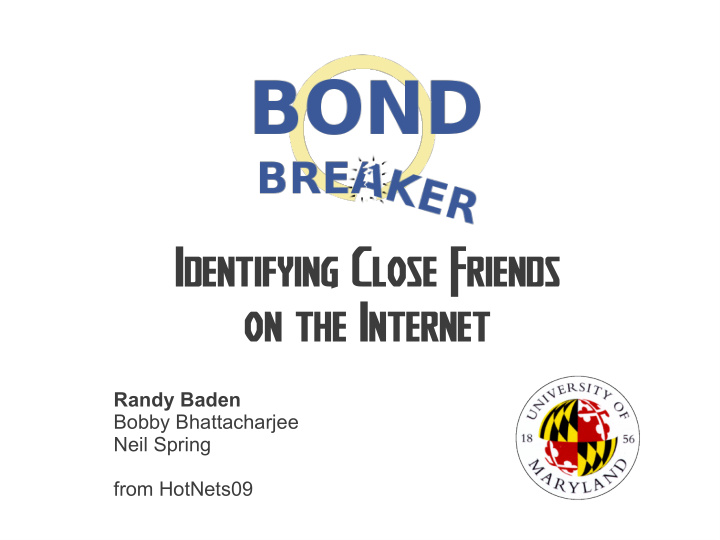



Identifying Close Friends on the Internet Randy Baden Bobby Bhattacharjee Neil Spring from HotNets09
Problem ● Security and privacy are only as good as the user's ability to identify with whom they wish to communicate ● Consequences of compromised friend edges: spam, phishing, viruses, privacy leaks, identity theft ● Correctly identifying online social network (OSN) users is difficult ● Impersonation is easy [Bilge, et al., WWW '09] ● Scale and context is unlike well-studied settings
Impersonation ● Copy public information from a different social network to create an impostor account ● Clone public information on the same social network ● Most users will not notice that there are two identical accounts, even if they have already added the friend ● Optionally, first infiltrate the user's social circle to invade privacy, then also clone private information
Solution ● Public key infrastructure (PKI) ● Usually: a centralized, trusted certificate authority publishes public keys for the actors in the system ● No central authority can verify the identity of every user of an OSN ● Decentralized identity verification ● Users responsible for verifying the identities of their neighbors in the social graph ● Advantage: OSN users have social knowledge
Exclusive Shared Knowledge ● Ask a question that only the friend can answer ● Some real examples ● Which celebrity do I always get confused with Sean Penn? ● How much did we spend on drinks last night? (nearest dollar, no $)
Exclusive Shared Knowledge ● Ask a question that only the friend can answer ● Some real examples ● Which celebrity do I always get confused with Sean Penn? – Liam Neeson ● How much did we spend on drinks last night? (nearest dollar, no $)
Exclusive Shared Knowledge ● Ask a question that only the friend can answer ● Some real examples ● Which celebrity do I always get confused with Sean Penn? – Liam Neeson ● How much did we spend on drinks last night? (nearest dollar, no $) – 104
Challenges ● Designing a protocol to resist known attacks ● Evaluate security of shared knowledge
Asker Impersonation Iron Man Thor Loki When didst we first assemble? 1963 1963 Consequence: verification is one-way; Iron Man incorrectly believes that Loki is Thor the asker identifies the askee
Askee Impersonation Thor Loki Iron Man What was Henry Pym's wife's name? Uhh... Janet? Janet Consequences: answer space should be large; Impostor guesses the correct answer protocol should not reveal information
Protocol ● Desired Properties ● One-way verification: at end, asker learns/confirms the askee's public key ● Zero-knowledge proof of possession of shared knowledge ● Interactive: immune to offline dictionary attacks ● Existing protocol: SPEKE [Jablon, Sigcomm96] ● Establishes a secure channel based on a shared passphrase ● Can be applied over an OSN as a browser extension
Can Users Ask Good Questions? A user study and a Facebook game
Rules ● Users are rewarded for forming “bonds” ● Users are punished for having their bonds broken ● Users are rewarded for breaking bonds ● Crowdsourced security penetration testing Asker Askee Impostor Bond Made +1 per bond +1 per bond - Bond Broken -2 per bond -1 per bond +1 per impostor
Data Collection ● April – June 2009 ● 171 registered participants ● 70 did not ask, answer, or try to break bonds ● 92 asked or answered at least once ● 9 only tried to break bonds ● Results consider only the 101 active participants
Friend Graph
Bond Graph
Ability To Ask
Break Attempts Friend Stranger All Unsuccessful 50% 44% 94% Successful 5% 1% 6% All 55% 45% 100%
Web of Trust
Web of Trust
Conclusion ● Users can ● Use exclusive shared knowledge to identify one- hop neighbors in a social network ● Sign and publish identifications to identify multi-hop neighbors and confirm verifications – 80% of broken bonds in the experiment also had a good path ● Enables a social PKI, useful for secure systems ● Bond Breaker is just part of the big picture
Identifying Close Friends on the Internet Randy Baden Bobby Bhattacharjee Neil Spring from HotNets09
Persona ● Distributed and decentralized OSN ● Users choose where to store their data ● Users store data encrypted with ABE – Key distribution mechanisms to use ABE, public key crypto, and symmetric key crypto in ways that support OSN communication patterns – Built on assumption that there's a social PKI ● Users need not trust third parties with data ● Can still provide content-agnostic applications, which includes most core OSN applications
Recommend
More recommend